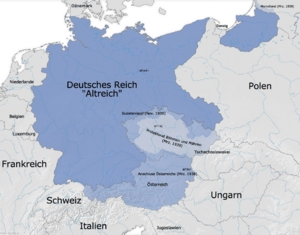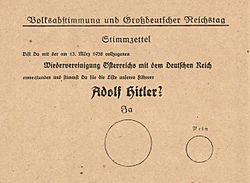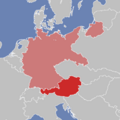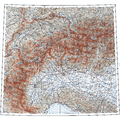Anschluss facts for kids
The Anschluss was when Germany took over Austria in 1938. The word "Anschluss" means "connection" or "joining" in German.
After World War I, the large empires of Austria-Hungary and Germany were broken up. Many people in Austria wanted their country to join with Germany. They hoped to create a "Greater Germany" that included all German-speaking people. However, the Treaty of Versailles, a peace agreement signed after the war, did not allow this.
Contents
Hitler's Demands
Adolf Hitler, who was born in Austria, met with Austrian Chancellor Kurt Schuschnigg on February 12, 1938. This meeting took place in Berchtesgaden, Germany. Hitler demanded that Austria lift its ban on political parties. He also wanted all imprisoned members of the Nazi Party to be set free. Hitler insisted that these Nazis be allowed to join the Austrian government.
Hitler threatened to invade Austria if his demands were not met. He said he would unite Austria and Germany by any means necessary. Schuschnigg felt he had no choice but to agree. He appointed Arthur Seyß-Inquart, a lawyer who supported the Nazis, as Interior Minister. Another Nazi, Edmund Glaise-Horstenau, was also given a government role.
Earlier in January 1938, Schuschnigg had been told to fire Alfred Jansa. Jansa was the chief of staff for the Austrian Army. He and his team had made plans to defend Austria from a German attack. Hitler did not want these defense plans to exist.
Schuschnigg soon realized his new Nazi ministers were trying to take over his government. To gain support, he allowed socialists and communists to appear in public again. These groups had been banned since the Austrian Civil War in 1934. The communists quickly offered their support to the Austrian government. The socialists wanted more promises from Schuschnigg before they would fully side with him.
The Referendum and Invasion
On March 9, Schuschnigg announced a plebiscite (a public vote) on Austria's independence. This vote was planned for March 13. To try and win the vote, Schuschnigg set the minimum voting age at 24. Many young people supported the Nazis and wanted to join Germany. This rule was meant to stop them from voting.
Hitler claimed the vote would be unfair and that Germany would not accept the results. The German Ministry of Propaganda spread false news. They reported that riots had broken out in Austria. They also claimed that many Austrians were asking for German troops to restore order. Schuschnigg immediately stated publicly that these reports were untrue.
On March 11, Hitler sent an ultimatum to Schuschnigg. He demanded that Schuschnigg hand over all power to the Austrian Nazis. If he refused, Germany would invade. Schuschnigg resigned as Chancellor that evening. He had tried to get help from France and Britain, but they would not intervene.
In his radio announcement, Schuschnigg said he was stepping down to avoid violence and bloodshed. Meanwhile, Austrian President Wilhelm Miklas refused to appoint Seyß-Inquart as Chancellor. He tried to find other Austrian politicians for the role. However, the Nazis were very organized. Within hours, they took control of many parts of Vienna, including the police headquarters.
President Miklas continued to refuse a Nazi government. Seyß-Inquart could not send a telegram asking for German troops in Austria's name. Hitler became very angry. Around 10 PM, Hitler had already ordered the invasion. His top official, Göring, and Hitler sent a fake telegram. It pretended to be a request from the Austrian government for German troops to enter Austria. Around midnight, after most important offices in Vienna were taken by Nazis, Miklas finally appointed Seyß-Inquart as Chancellor.
German Troops Enter Austria
On the morning of March 12, the German Wehrmacht (army) crossed the border into Austria. The Austrian Army did not stop them. Instead, German troops were met by cheering Austrian Germans. People gave Hitler salutes, waved Nazi flags, and offered flowers. Because Austria was taken over without a single shot, this event is sometimes called the Blumenkrieg (war of flowers).
Hitler's car crossed the border that afternoon in Braunau am Inn, his birthplace. That evening, he arrived in Linz and was welcomed at the city hall. Göring said on the phone that night, "There is unbelievable jubilation in Austria. We ourselves did not think that sympathies would be so intense."
On April 2, 1938, 200,000 Austrians gathered in the Heldenplatz (Square of Heroes) in Vienna. They came to hear Hitler announce the Austrian Anschluss. Hitler later claimed that foreign newspapers lied about brutal methods. He said he had never experienced such a wave of love as when he entered Austria. He stated, "Not as tyrants have we come, but as liberators."
The Anschluss became official with a law on March 13, but it needed to be approved by a public vote. The vote was held on April 10. Officially, 99.73% of voters supported the Anschluss. Most historians agree that the result was not completely made up. However, the voting process was not free or secret. Officials were often right next to the voting booths. Voters handed in their ballots directly, instead of putting them into a closed box.
In some parts of Austria, the original vote on independence (planned for March 13) still happened. This was even with the German army present. For example, in the village of Innervillgraten, 95% voted for Austria's independence.
Austria remained part of Nazi Germany until the end of World War II. On April 27, 1945, a temporary Austrian government declared the Anschluss "null and void" (meaning it never legally happened). After the war, Austria was occupied by the Allies. It was recognized as a separate country. Austria did not become fully independent until 1955, with the Austrian State Treaty and its Declaration of Neutrality. This was partly due to the start of the Cold War.
Images for kids
-
The territory of the German Reich and Austria after World War I
-
The dissolution of Austria-Hungary in 1918
-
Seyss-Inquart and Hitler with Himmler and Heydrich to the right in Vienna, March 1938
See also
 In Spanish: Anschluss para niños
In Spanish: Anschluss para niños














